Pan fried salmon is delicious when cooked in butter and olive oil. The skin becomes wonderfully crispy, and the flesh is juicy and flavorful. Who needs fast food when this homemade dish is ready in fifteen minutes?
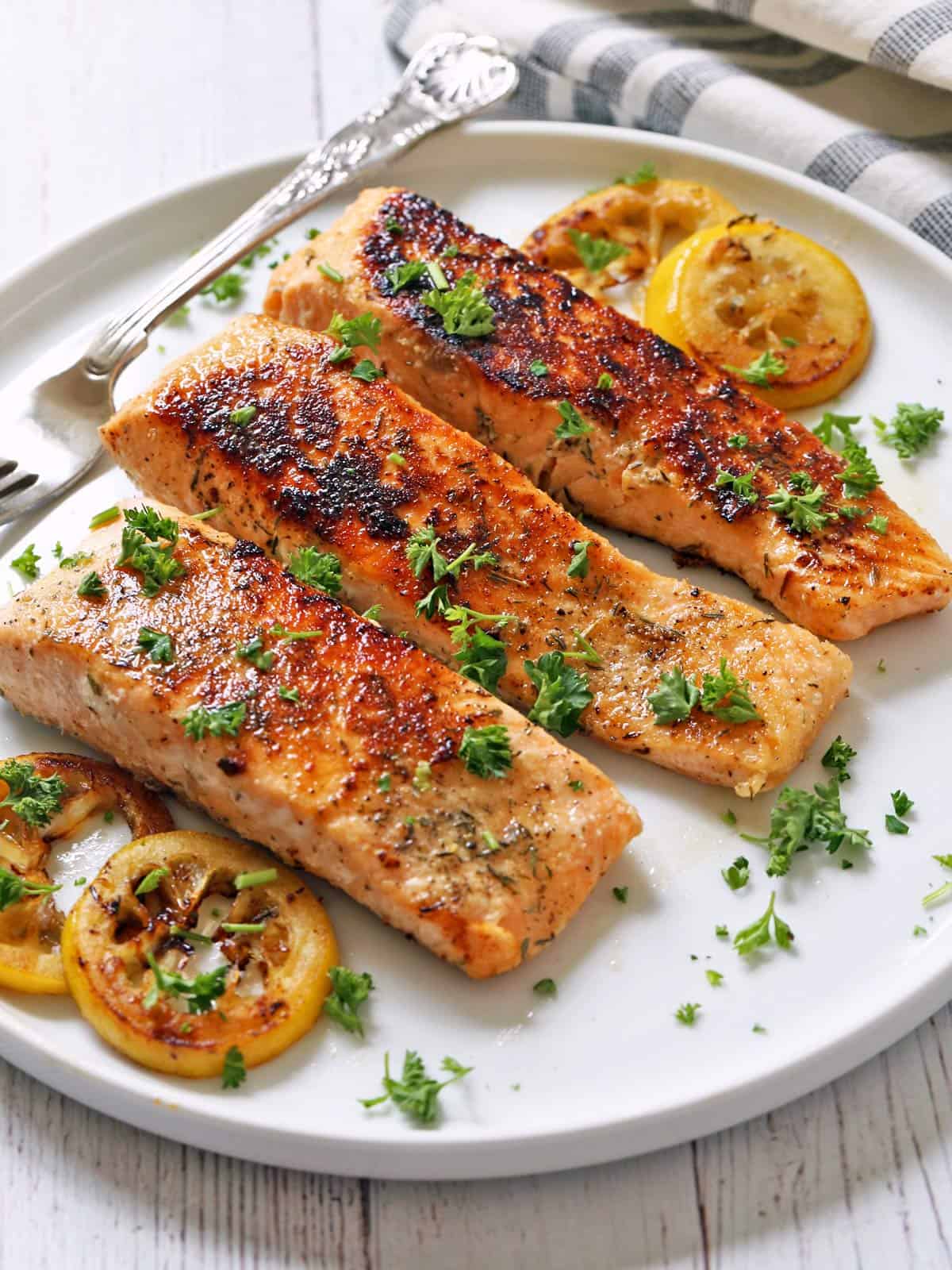
I enjoy salmon recipes like baked salmon and grilled salmon, but this pan fried salmon is especially good because the skin becomes wonderfully crispy when seared in butter in a hot skillet. The bonus: it's an easy meal to prepare, making it suitable for a quick weeknight dinner.
Ingredients and Variations
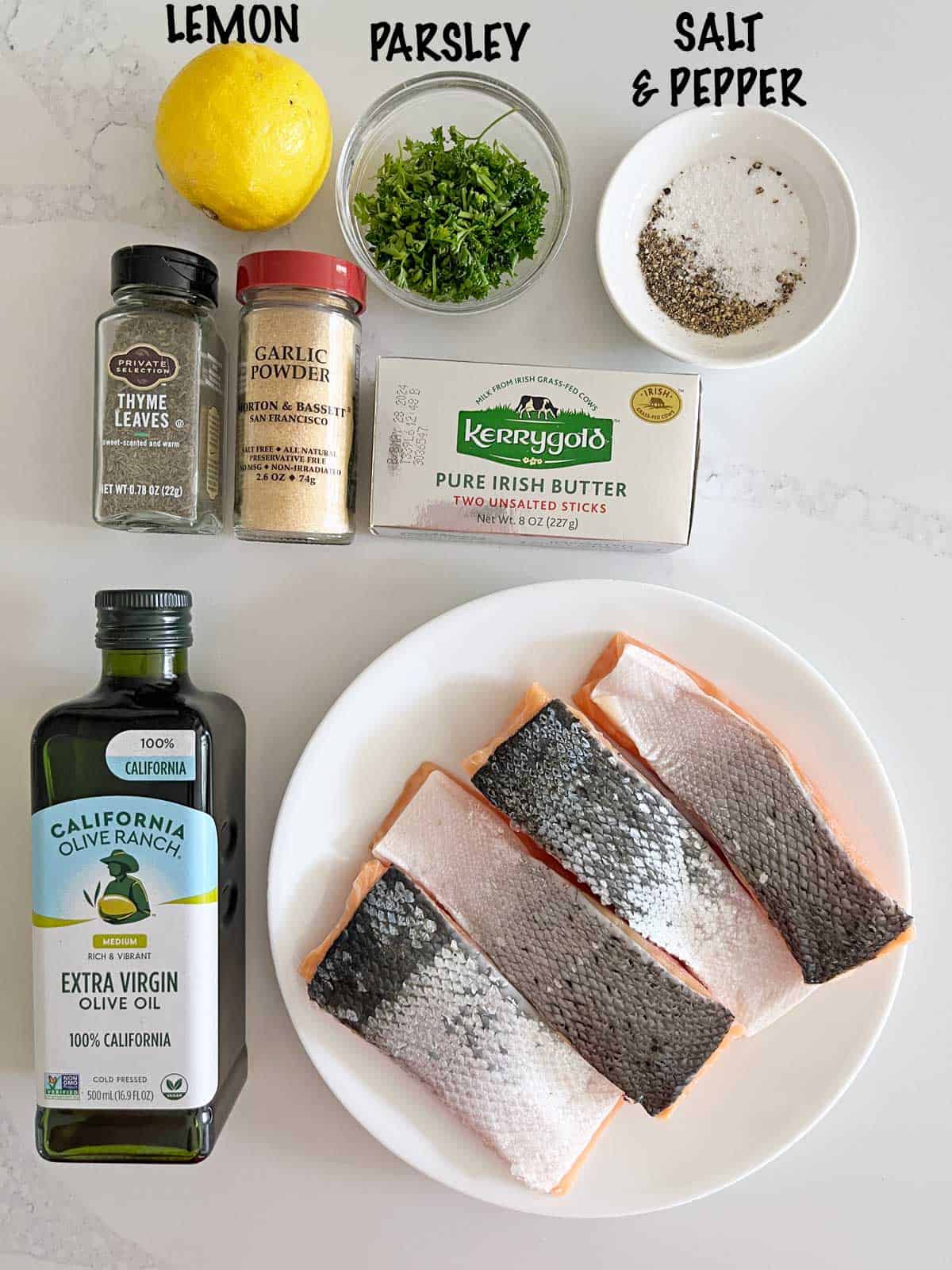
See the recipe card for exact measurements. Here are my comments on some of the ingredients.
- Salmon fillets: I prefer skin-on fillets. Salmon skin is delicious, especially in this recipe, where it becomes crispy.
- To season: Kosher salt, black pepper, garlic powder, and dried thyme.
- For frying: I use a mix of olive oil and butter. You can skip the butter and cook the salmon in two tablespoons of olive oil. However, butter enhances the salmon's flavor. Alternatively, you can skip the olive oil and use two tablespoons of butter. The butter's milk solids have a blackening effect (similar to blackened salmon), making the salmon extra crispy.
- Optional additions: Lemon slices and chopped parsley.
Instructions
The detailed instructions and step-by-step photos are included in the recipe card. Here's a quick overview.
Season the salmon with salt, pepper, garlic powder, and dried thyme. Heat olive oil and butter in a large skillet. When the butter starts foaming, add the salmon fillets, skin-side down. You can add lemon slices, too.
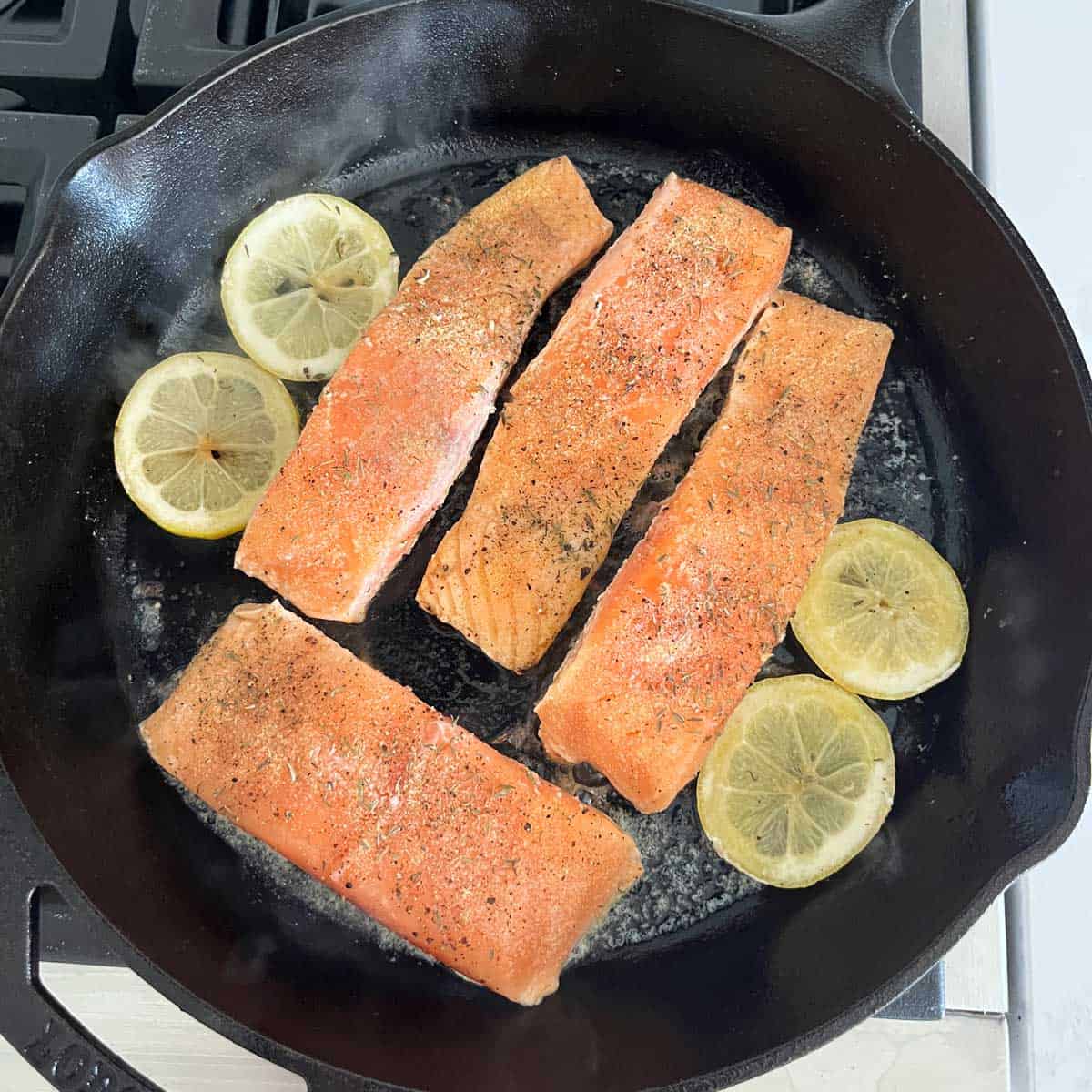
Sear the salmon, undisturbed, until the skin is crisp and browned, about 4 minutes. Flip it, lower the heat to medium, and cook it for 2-3 more minutes or until it's cooked through. Its internal temperature, as measured in the thickest part, should reach 145°F.
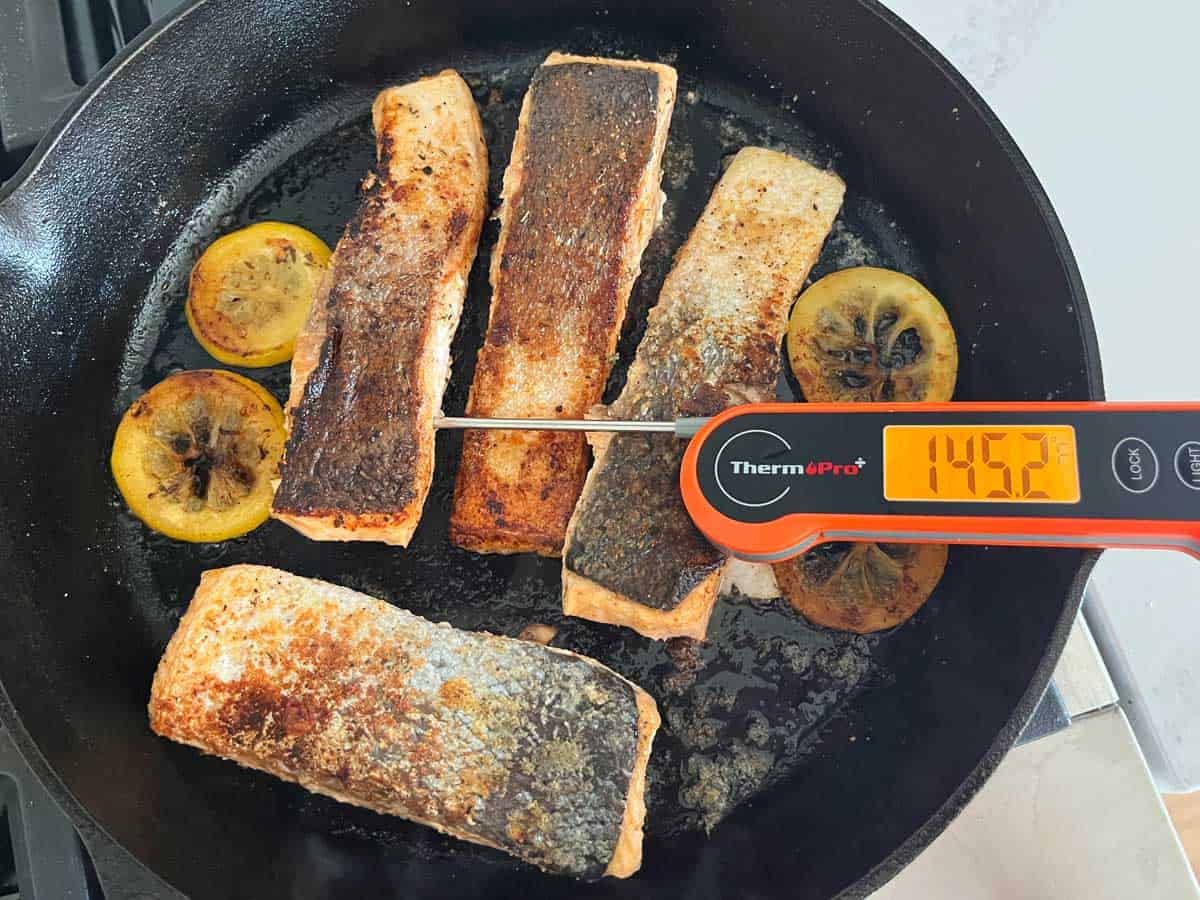
Transfer the cooked salmon to a plate, drizzle it with the pan juices, garnish with lemon and parsley, and serve.
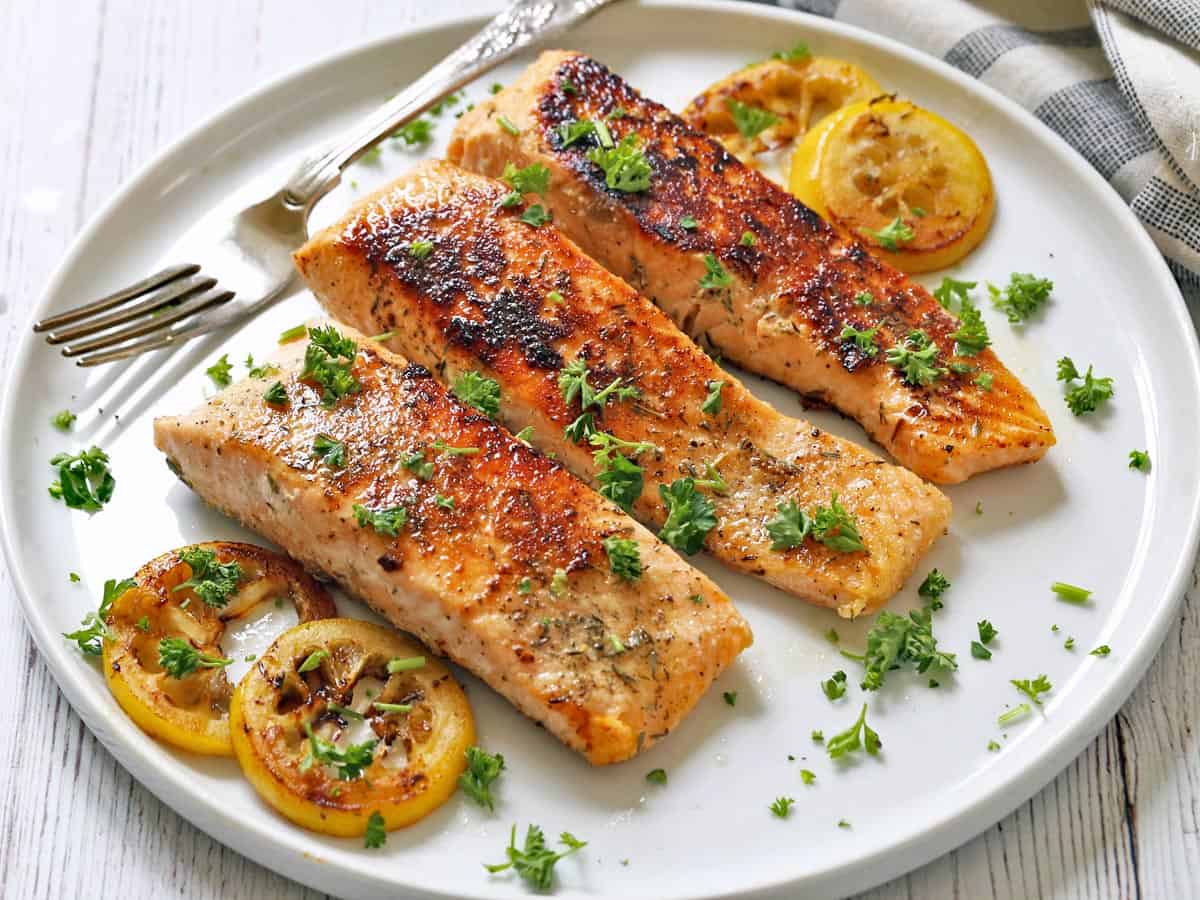
This is a fantastic recipe. Excellent taste and easy to prepare. Thanks for sharing.
Alex
Read more comments
Recipe Tips
- Don't forget to drizzle (or brush) the salmon with the pan juices after you've arranged it on plates. The pan sauce is buttery and rich. It adds wonderful flavor to the dish.
- The best skillets for this recipe are nonstick or well-seasoned cast-iron skillets. I don't recommend using a stainless steel skillet - the salmon skin tends to stick to it.
- If your fillets are 1 inch thick, cook the edges for about 2 minutes per side. This helps ensure that the salmon's internal temperature reaches 145ºF. See the photos below - the first one shows how the edges are still raw even after the salmon was seared on both sides. The second photo shows that the edges are fully cooked - and so is the entire fillet.
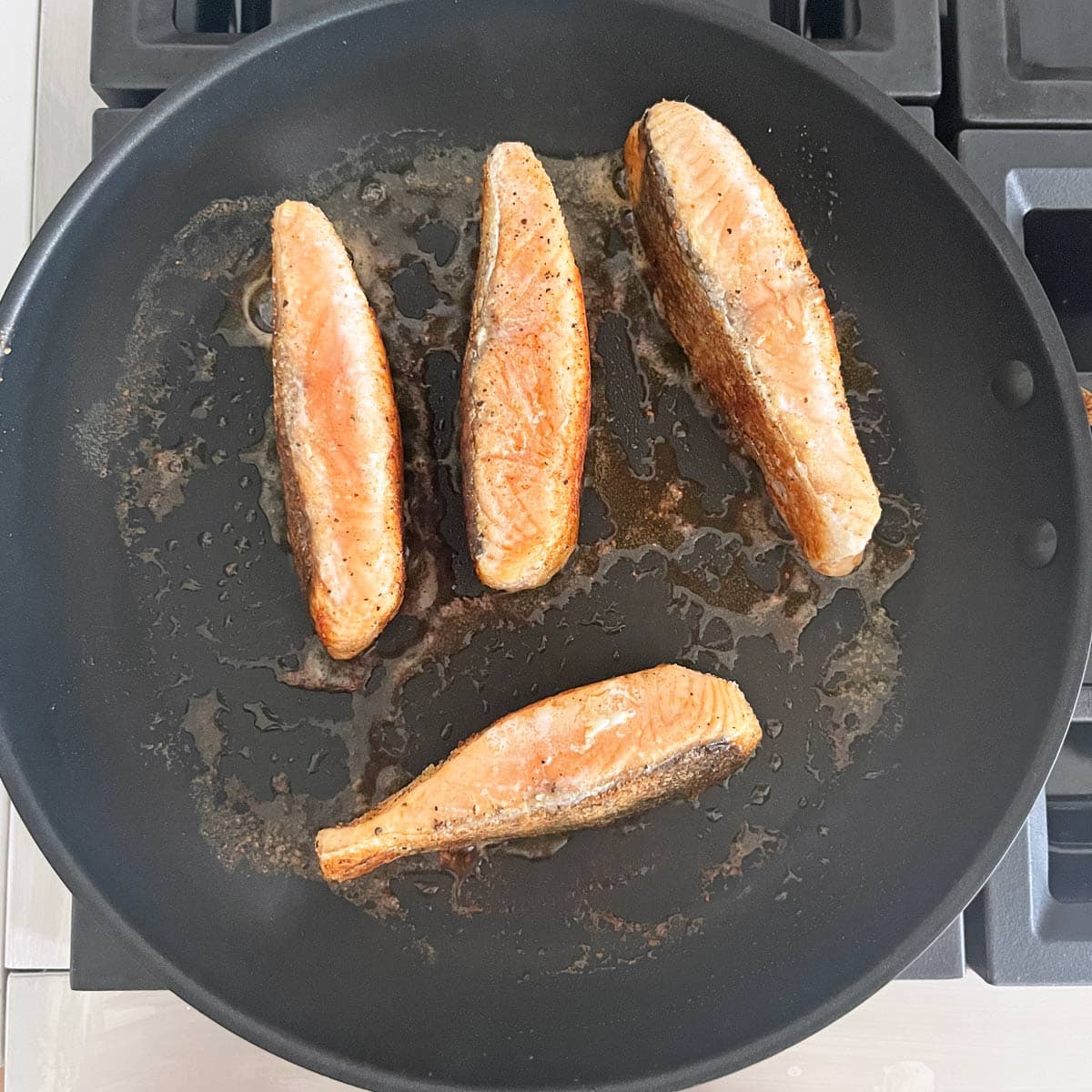
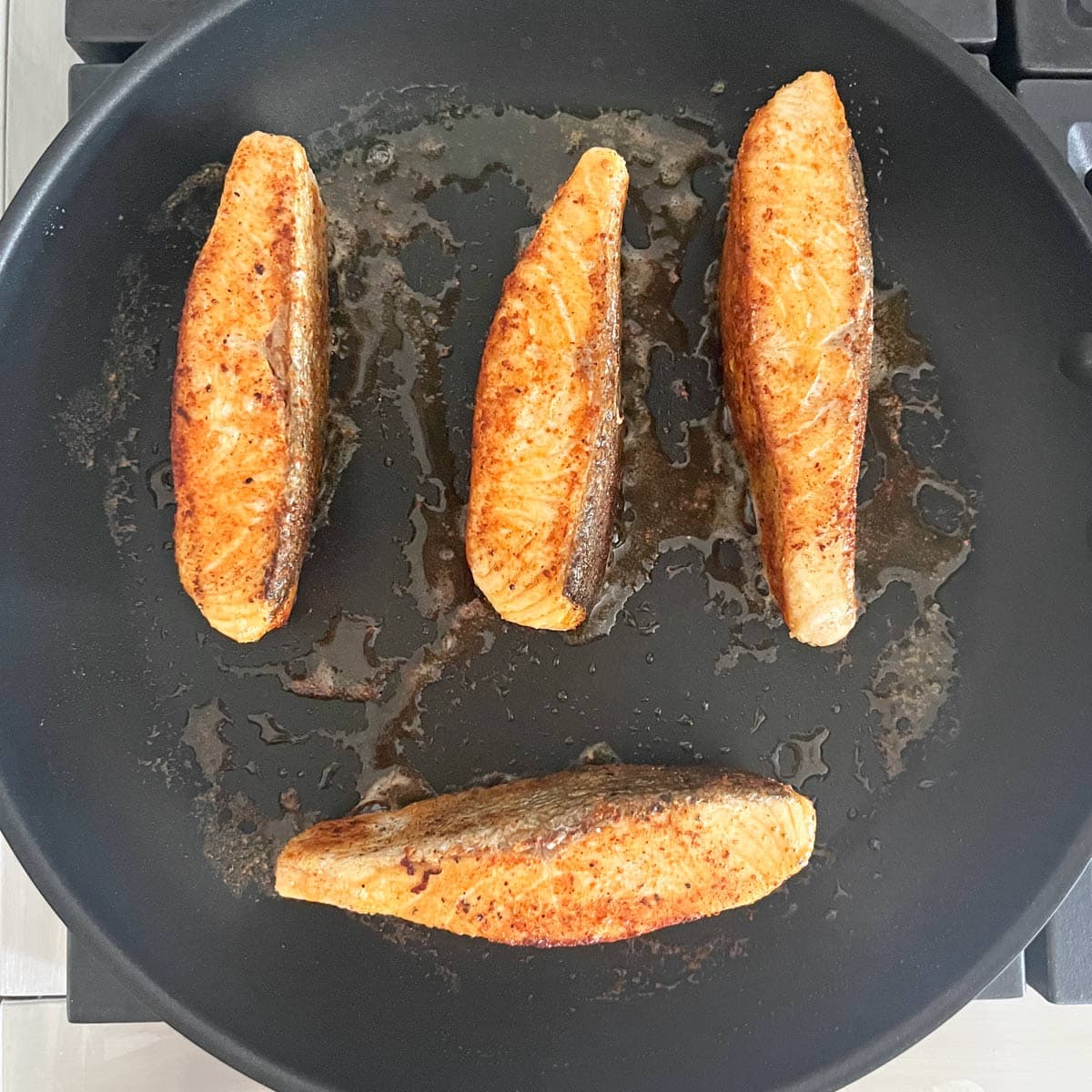
- If you purchase bags of frozen salmon like I do, inevitably, some of the fillets will be wider and thinner, as shown in the photo below. That's OK. You can pan-fry them the same way you do the thicker fillets, but you can skip cooking the edges. Transfer them to a plate while you finish cooking the thicker ones.
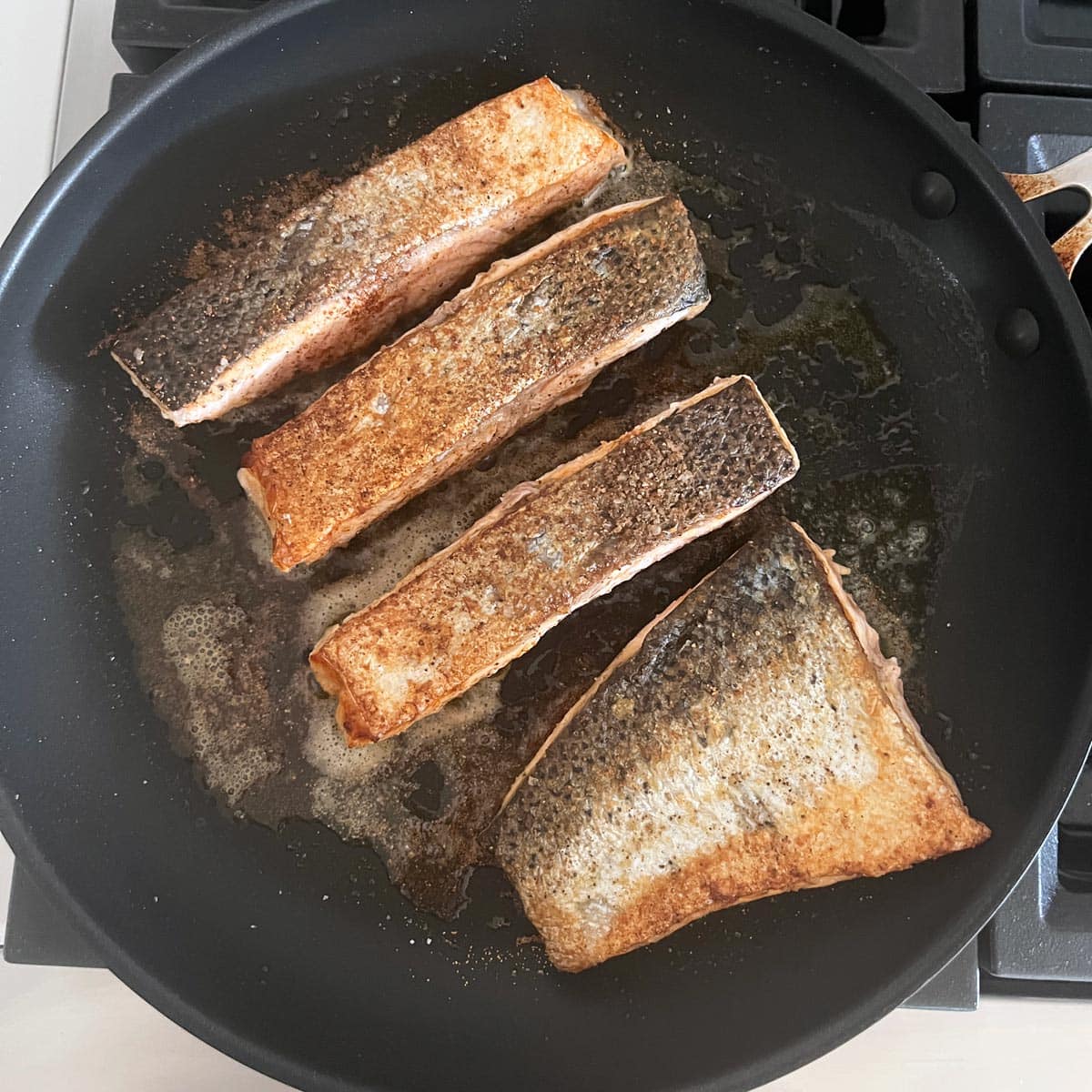
Recipe FAQs
When salmon is done, it transforms from red and translucent to pink and opaque.
The USDA recommends cooking fish to an internal temperature of 145°F. While many cooks feel it's better to cook salmon to an internal temperature of 125°F or 130°F and let it rest for five minutes, I prefer to err on the side of caution and cook fish to an internal temperature of 145°F.
Apart from using a thermometer, another way to check for doneness is to gently press on the top of the fish with a fork. If the flesh flakes (separates) easily, the salmon is done. But the only way to know for sure is to use a thermometer.
Cook the salmon skin-side down for about four minutes over medium-high heat. Turn it to the other side only after you can see (when lifting the edge) that the skin is browned.
It's also helpful to add enough fat to the frying pan, use butter (its milk solids have a blackening effect), and use a well-seasoned cast-iron skillet.
Yes. I love salmon skin, especially when fried and crispy. But if you prefer to cook it without the skin, simply follow the same instructions, cooking it for about 3 minutes per side.
No. I recommend thawing the salmon before using it in this recipe. It's OK to use frozen salmon when baking salmon in the oven. But when pan-frying, the salmon should be thawed to make sure it is evenly cooked.
Yes. You can keep them in an airtight container in the fridge for up to three days. I prefer to avoid reheating them because reheating can dry them out and make them taste fishy. Instead, I crumble them cold (removing the skin first) over a salad like this arugula salad, or use the cold salmon in this Cobb salad instead of chicken. Sometimes, I chop the leftovers, mix them with cream cheese, and have that for my lunch the next day on thick slices of almond flour bread.
Serving Suggestions
This is a versatile main dish that goes with anything. The three photos below show it served with three different sides: sauteed green beans (it's also good with haricot verts), roasted broccoli, and tomato salad with mozzarella and olives.


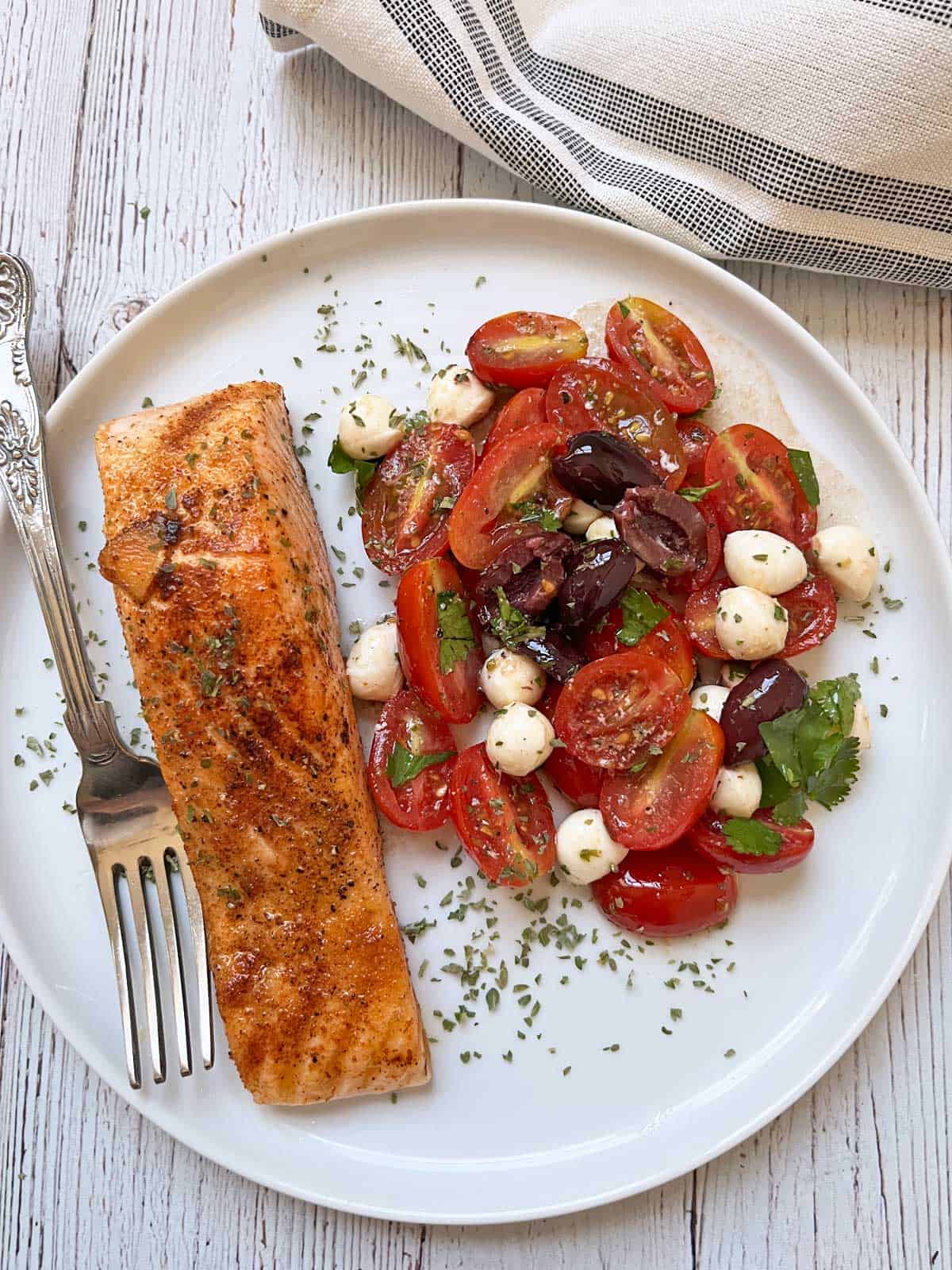
Recipe Card
Crispy Pan Fried Salmon
Video
Ingredients
- 4 salmon fillets - 6 ounces each, 1-inch thick, skin on, pin bones removed
- ½ teaspoon Diamond Crystal kosher salt - or ¼ teaspoon of any other salt, including Morton kosher salt
- ¼ teaspoon black pepper
- ½ teaspoon garlic powder
- ¼ teaspoon dried thyme
- 1 tablespoon olive oil
- 1 tablespoon butter
Optional Ingredients:
- 4 lemon slices - ¼-inch thick
- 2 tablespoons parsley - chopped
Instructions
- Blot the salmon fillets dry with paper towels. Season them with salt, pepper, garlic powder, and dried thyme.
- Heat a large (12-inch) cast-iron skillet over medium-high heat. Add the olive oil and butter and swirl to coat. You can also use a nonstick skillet.
- When the butter starts foaming, add the salmon fillets, skin-side-down. If using, add the lemon slices.
- Cook the salmon, undisturbed, until the skin is crispy and browned, for about 4 minutes. Flip the salmon and lemon slices, lower the heat to medium, and continue cooking for 3 more minutes.
- If your fillets are 1 inch thick, cook the edges for about 2 minutes per side. This helps ensure the salmon reaches an internal temperature of 145ºF.
- Transfer the salmon fillets to a serving plate and drizzle them with the pan juices. Garnish the plate with lemon slices and chopped parsley, and serve.
Notes
- If your salmon is frozen, thaw it thoroughly before using it in this recipe. You can thaw it overnight in the fridge.
- You can skip the olive oil and use two tablespoons of butter. The butter's milk solids have a blackening effect, making the salmon extra-crispy.
- The best skillets for this recipe are nonstick or well-seasoned cast-iron skillets. I don't recommend using a stainless steel skillet - the salmon skin tends to stick to it.
- Don't forget to drizzle the salmon with the pan juices after you've arranged it on the plates. The pan sauce is delicious.
- You can keep the leftovers in an airtight container in the fridge for up to three days. I prefer to avoid reheating them because reheating can dry them out and make them taste fishy. Instead, I crumble them cold over a salad.
Nutrition per Serving
Save this Recipe!
We will also add you to our weekly newsletter. Unsubscribe anytime. See healthyrecipesblogs.com/privacy/ to learn how we use your email.
Disclaimers
Most recipes are low-carb and gluten-free, but some are not. Recommended and linked products are not guaranteed to be gluten-free. Nutrition info is approximate. Please verify it independently. The carb count excludes non-nutritive sweeteners. Please read these Terms of Use before using any of my recipes.


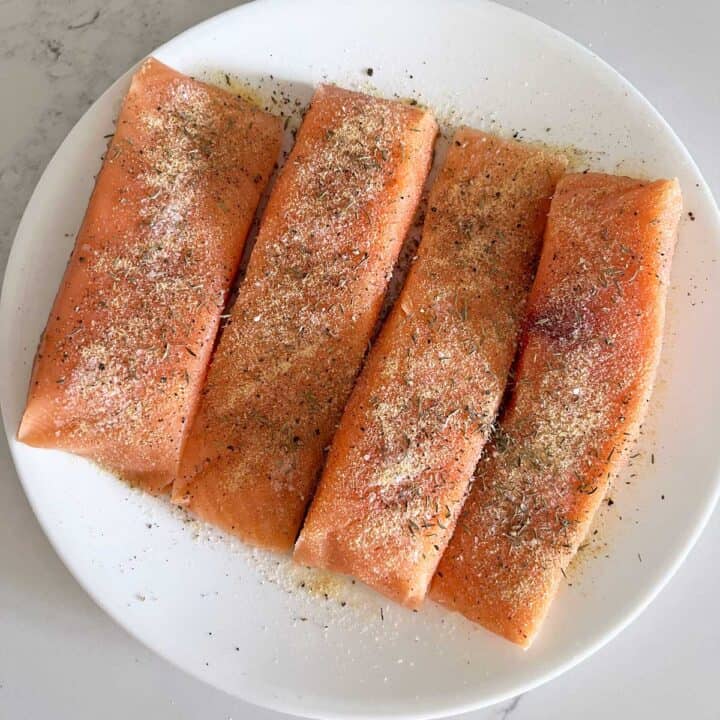
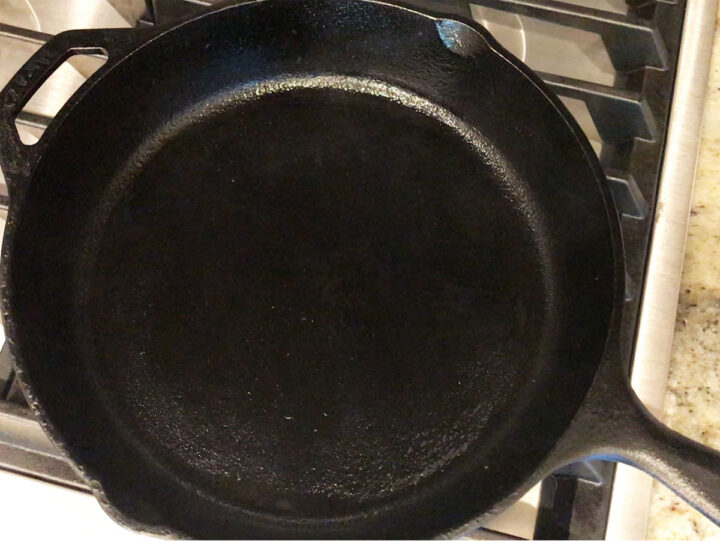
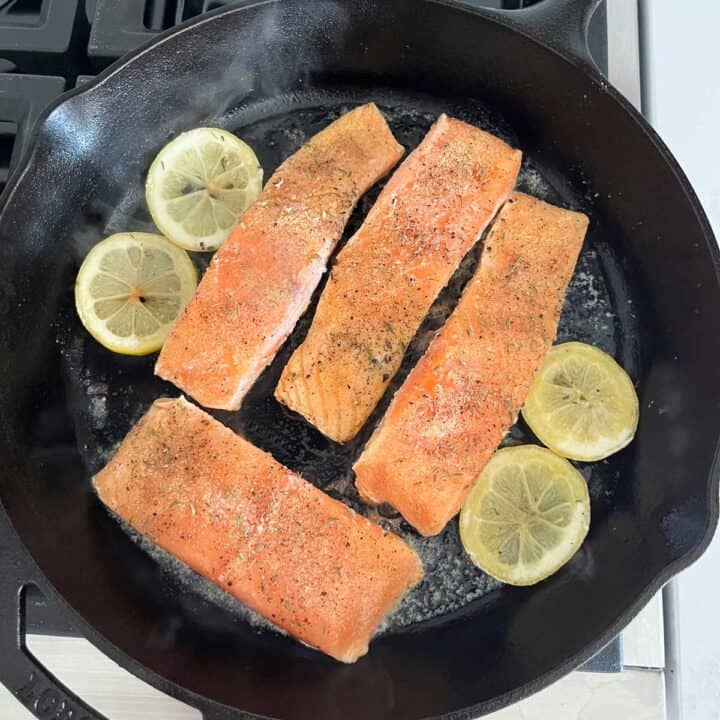



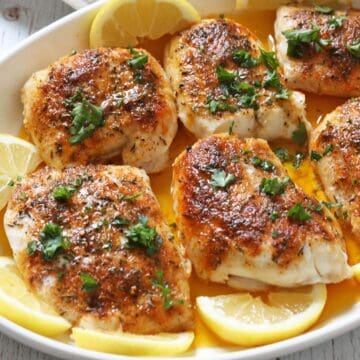
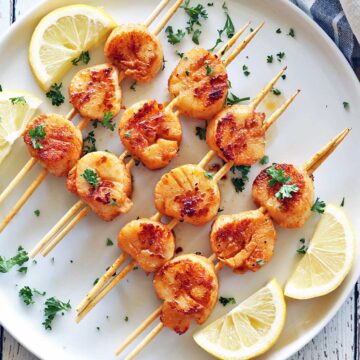


Tammy Tucker says
hi. I love salmon .. but I just have a question... I've been told to only season the salmon skin with kosher salt right before adding to heated pan because of the salt drawing moisture from it and that olive oil doesn't have enough heating effectiveness, to use avocado oil or ghee oil? just curious... I'm cooking for dinner tonight...woohoo
Vered DeLeeuw says
Hi Tammy,
I love this recipe as written and make it weekly, but it's fine to season the skin right before placing the salmon in the pan. It's also fine to substitute avocado oil for the olive oil.
Alex says
Vered,
This is a fantastic recipe. Excellent taste and easy to prepare. Thanks for sharing.
Alex
Vered DeLeeuw says
You're very welcome, Alex. I'm so glad you enjoyed this recipe. I make it weekly!
Olivia Sessi says
This was easy for me to cook and tasted so good!! Thanks for sharing your recipe.
Vered DeLeeuw says
I'm so glad you enjoyed this recipe, Olivia!